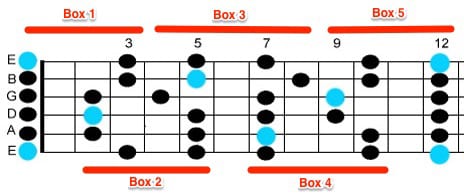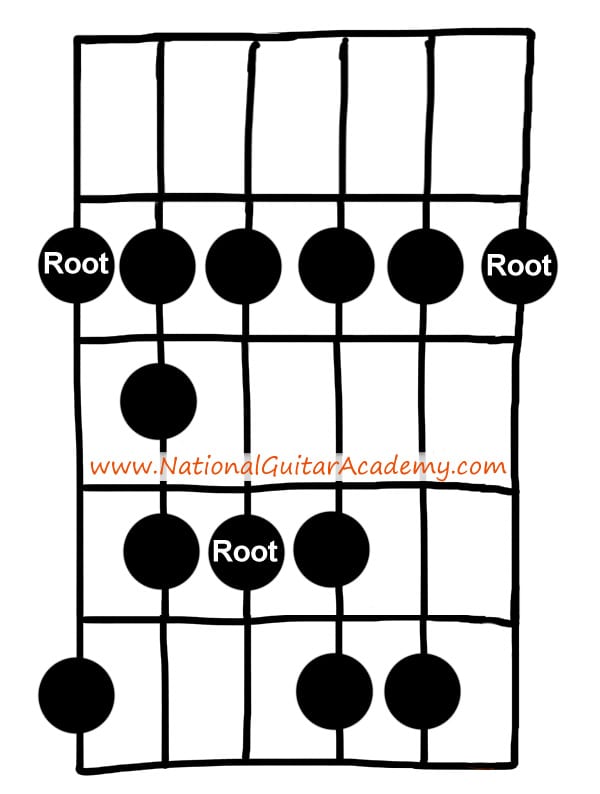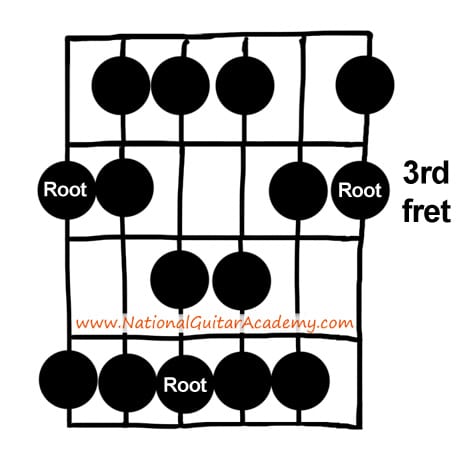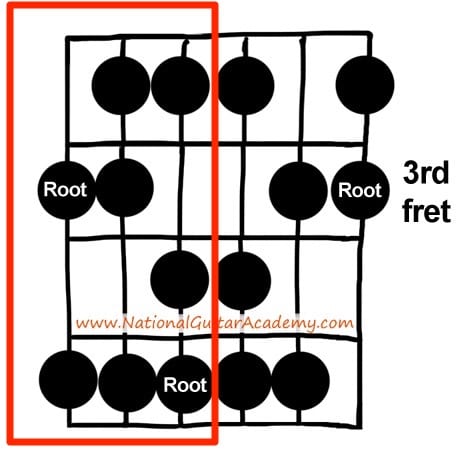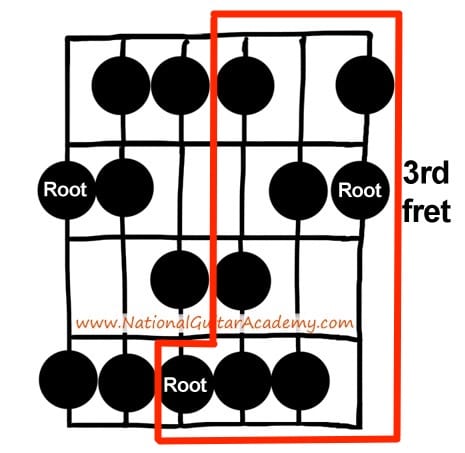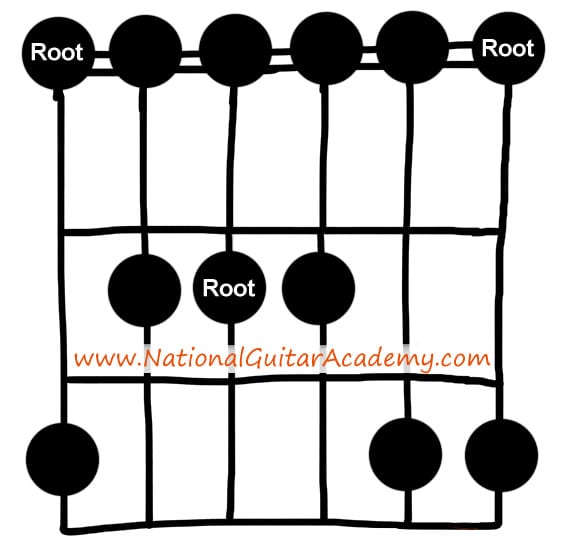A quick note on ‘boxes’
The guitar neck is long and the notes overlap from one string to the next. There is no way we can memorise all the patterns in one go.
- To make life easier for ourselves we divide all scales on the neck into 5 segments to make things more manageable.
- You can play every scale in each segment. We call these segments ‘boxes’.
For example, with no boxes, this is what the full neck diagram looks like for the E Minor Pentatonic Scale.
- This is overwhelming! So we do what we always do. We simplify.
- We break this long pattern into 5 shorter patterns. These 5 smaller patterns are called ‘boxes’.
So for each scale, we have box 1, box 2, box 3, box 4 and box 5. (After the 12th fret, the 5 box patterns repeat again.)
As you can see, the boxes overlap. The right side of box 1 is the left side of box 2. And so on.
- From a music theory point of view, the notes in all 5 boxes follow the same musical pattern. They are the same scale.
- But when these notes are laid out across the guitar fretboard the fives boxes look very different from one another.
- They all share the same musical ‘DNA’, but their appearance is different.
That means we have to learn multiple patterns to play the same scale in different positions on the guitar neck.
Don’t worry about learning boxes 2, 3, 4 and 5 right now. Just focus on box 1 for each scale.
Master box 1 of each scale before attempting others
In this article, to keep things simple, we’ve just used box 1 for each scale. This is how you should approach this too.
This is by far the best way to learn guitar scales. Just learn box 1’s for now, but know that there are 4 more boxes for every scale. You can move onto these in the future! 🙂
Ok let’s look at my favourite scale of all, the Blues Scale. This is why we learn guitar scales!
The Blues Scale
The Blues Scale is a very close relative of the Minor Pentatonic Scale. It sounds awesome in most rock, indie, country and blues scenarios.
It looks like this:
The Blues Scale
One of the coolest things about the Blues Scale is that you can often play it over both major and minor keys.
It won’t work over every chord progression, but it does work over lots. It’s a versatile scale.
If you’re trying to learn guitar scales this is a huge boost, because it makes everything easier.
.
Keys
If you want to learn guitar scales because you intend to play lead guitar you need to know this:
The easiest way to play lead guitar that will sound “good” is to play notes from a scale that matches the song’s key.
This is so important I’m going to re-type it!!
The easiest way to play lead guitar that will sound “good” is to play notes from a scale that matches the song’s key.
So if the key of a song is C Major, you will sound awesome if you play a riff or solo with notes from the C Major Scale. In this example, the key and the scale match. Voila! We have harmony.
How to work out the key of a song
The easiest way to work this out is to look at the first and last chord of the song. (They’re often the same chord.) 99% of the time the key of the song will be one of those two chords.
A key-finding example
So for example, let’s say the first chord of the song is A minor.
This means that you can play any note from the A Minor Scale (or the A Minor Pentatonic Scale) and it will sound good. Some notes will sound better than others, but none of them will sound ‘bad’.
Let’s look at another example
Let’s say the first chord of the song was E major. You could play any note from the E Major Scale (or the E Major Pentatonic Scale) and it would sound good.
Depending on the track, you may also be able to play the E Minor Scale, or the E Minor Pentatonic Scale too. If it’s a rock track, the E Blues Scale might also work.
NINJA TIP: You can often play a minor scale over a major key. This will often sound good. This does not work as well the other way around! Try it and you’ll HEAR the difference.
.
How to practice scales
When we learn guitar scales the first thing we need to do is commit the scale pattern to memory.
- The easiest way to do this is to break the scale into bite-sized chunks. So first of all, focus only on box 1 for the scale.
- The notes of all boxes cover two octaves. So we can make things even easier by just focussing on the first octave of box 1.
So the easiest way to learn guitar scales is to ‘split’ the scale boxes into octaves 1 and 2.
An example of how to learn a guitar scale
Let’s use the G Major Scale as an example. Box 1 looks like this:
To begin with, focus on learning the first octave. This is the distance from the first to the second root note. In this box, for this scale, the first octave spans strings 6, 5 and 4:
After you’ve memorised this, move onto the second octave, which spans strings 4 to 1:
Important point: Note that the last note of octave 1 is also the first note of octave 2. There are 8 notes in each octave, but there are not 16 notes in total across two octaves. There are only 15.
Why learn this way?
To learn guitar scales we have to break things into bite-size chunks. It just makes things faster.
This octave-splitting method might not seem necessary for box 1 of easy patterns like the Minor Pentatonic Scale, but for more complicated scales/boxes with more elaborate patterns this approach can make things a lot more manageable and allow us to learn guitar scales quickly and more reliably.
.
Here’s an important piece of technique
Remember to use one finger per fret, like this:
It’s ok to use the pads (the fingerprints) to play notes when you play lead guitar.
This is something that should be avoided at all costs when playing chords, but when we’re trying to learn guitar scales it’s ok to adapt our fretting technique. In fact, it’s flat out beneficial! 🙂
Learn slowly and correctly to embed good muscle memory
When we learn guitar scales it’s very important to learn slowly AND correctly. You must resist the urge to play fast. Playing slowly and correctly is the best way to embed muscle memory. Playing quickly leads to mistakes, frustration and twitchy muscle memory. That’s not what we want.
Practice ascending and descending the scales, but also try doubling back on yourself in different amounts.
- For example: ascend two notes, then descend one, ascend two, then descend one (and so on).
- Then try ascending 3 and descending one.
These are useful ways to learn the scales rote, but of course let’s not lose sight of the final aim here which is to develop a sense of musicality.
Nothing will improve your ability to learn guitar scales and play lead guitar more than jamming.
It is essential that you play the scales over MUSIC.
Don’t become the classic bedroom guitarist. The type of people who simply learn guitar scales and patterns in isolation. No!
You need to develop a feel for these patterns. Play the scales over backing tracks (YouTube is filled with them) and reach out and connect with other musicians who live locally to you.
Playing with other musicians is transformative for your progress as a guitarist.
Jam exercise – Try this backing track
Hit play on the backing track below and play jam with some notes from the E Minor Pentatonic Scale:
What Type of Guitarist Are You?
Take our 60-second quiz & get your results: Take The Quiz
Join the world's best online guitar school 🌎
- Get your own personalised guitar learning plan (customised just for YOU).
- World-class online guitar courses. Learn at your own pace.
- Community Campus & Learning Forum - A friendly community! Connect with our team & students. 😊
- Beginner Song library with chordsheets, tabs and tips. (Songs suitable for all levels!)
- Regular live streams, seminars and Q&A sessions - Learn from world-class guitar educators. Get all your questions answered!
Click here to learn more about National Guitar Academy membership 
Cool Guitar T-shirts 😎
Look cooler! Check out our merch: Click here to see our merch store
Want free guitar tips and video lessons delivered to your inbox?
Join over 100,000 guitar-learners and subscribe to our guitar-tips-by-email service. (It's free.)
We'll send you a series of lessons that will move you to the next level of your guitar journey.
Learn how everything fits together quickly, easily and effectively. We share ninja tips (for instant fun!) but also timeless fundamentals that will deepen your understanding.

Popular Lessons
How To Learn Guitar: An 11-Step Programme For Beginners
How To Choose The Perfect Beginner Guitar
More Cool Guitar Stuff
Learn about National Guitar Academy: About Us
Join us on Facebook for daily guitar tips.
Listen to our Learn Guitar Podcast for rapid guitar progress.
Check out our free chord lessons.
Get our best guitar tips & videos


